Hilton Hotel UK: Green Practices and Competitive Advantage Study
VerifiedAdded on 2020/01/28
|44
|16097
|53
Report
AI Summary
This report delves into the green practices adopted by UK hotels, with a specific focus on the Hilton Hotel. It begins by outlining the research rationale, aims, objectives, and research questions, followed by a comprehensive literature review exploring relevant theories and models of green practices within the hospitality sector. The research methodology chapter details the research philosophy, approach, design, data collection methods, and sampling techniques. The report then presents a qualitative data analysis using secondary research, including thematic analysis of interviews with Hilton Hotel managers. The findings are synthesized in the conclusion and recommendations chapters, offering insights into how green practices contribute to gaining a competitive advantage. The study emphasizes the increasing importance of sustainability in the hospitality industry and its positive impact on a company's performance and market position, as well as the increasing awareness among the public regarding environmental concerns. This report provides a detailed examination of how Hilton Hotel has adopted green practices, reduced its environmental footprint, and gained recognition for its sustainability efforts, including certifications and awards.
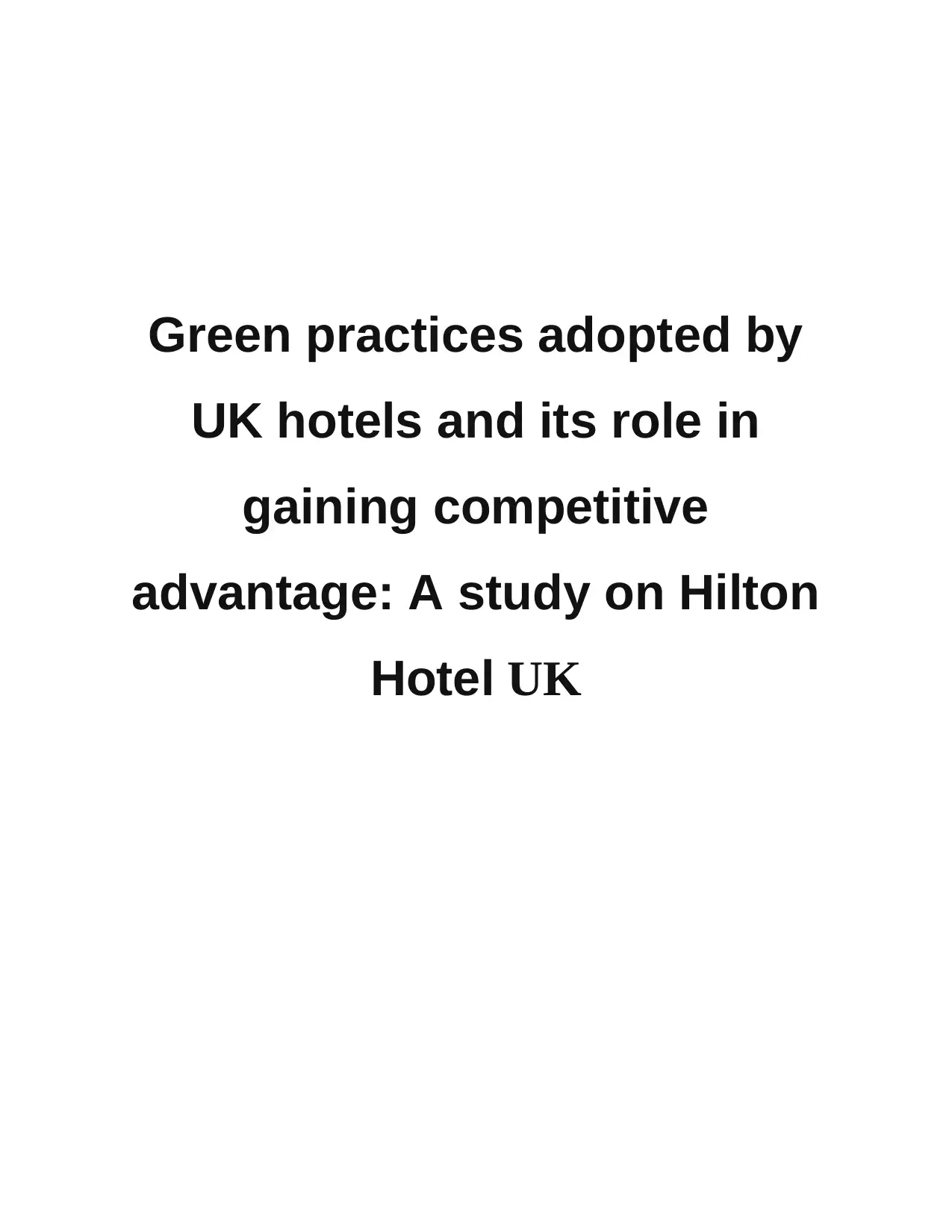
Green practices adopted by
UK hotels and its role in
gaining competitive
advantage: A study on Hilton
Hotel UK
UK hotels and its role in
gaining competitive
advantage: A study on Hilton
Hotel UK
Paraphrase This Document
Need a fresh take? Get an instant paraphrase of this document with our AI Paraphraser
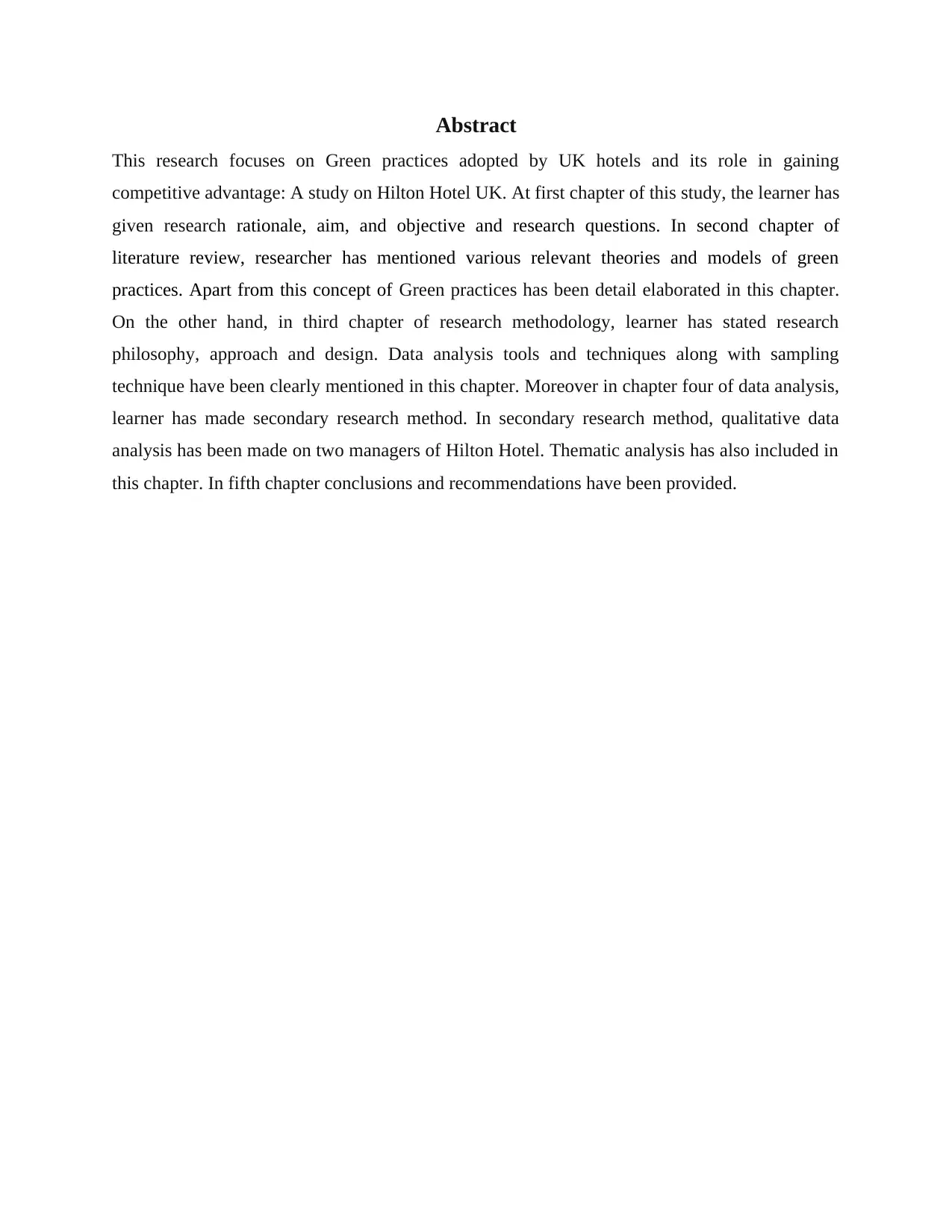
Abstract
This research focuses on Green practices adopted by UK hotels and its role in gaining
competitive advantage: A study on Hilton Hotel UK. At first chapter of this study, the learner has
given research rationale, aim, and objective and research questions. In second chapter of
literature review, researcher has mentioned various relevant theories and models of green
practices. Apart from this concept of Green practices has been detail elaborated in this chapter.
On the other hand, in third chapter of research methodology, learner has stated research
philosophy, approach and design. Data analysis tools and techniques along with sampling
technique have been clearly mentioned in this chapter. Moreover in chapter four of data analysis,
learner has made secondary research method. In secondary research method, qualitative data
analysis has been made on two managers of Hilton Hotel. Thematic analysis has also included in
this chapter. In fifth chapter conclusions and recommendations have been provided.
This research focuses on Green practices adopted by UK hotels and its role in gaining
competitive advantage: A study on Hilton Hotel UK. At first chapter of this study, the learner has
given research rationale, aim, and objective and research questions. In second chapter of
literature review, researcher has mentioned various relevant theories and models of green
practices. Apart from this concept of Green practices has been detail elaborated in this chapter.
On the other hand, in third chapter of research methodology, learner has stated research
philosophy, approach and design. Data analysis tools and techniques along with sampling
technique have been clearly mentioned in this chapter. Moreover in chapter four of data analysis,
learner has made secondary research method. In secondary research method, qualitative data
analysis has been made on two managers of Hilton Hotel. Thematic analysis has also included in
this chapter. In fifth chapter conclusions and recommendations have been provided.
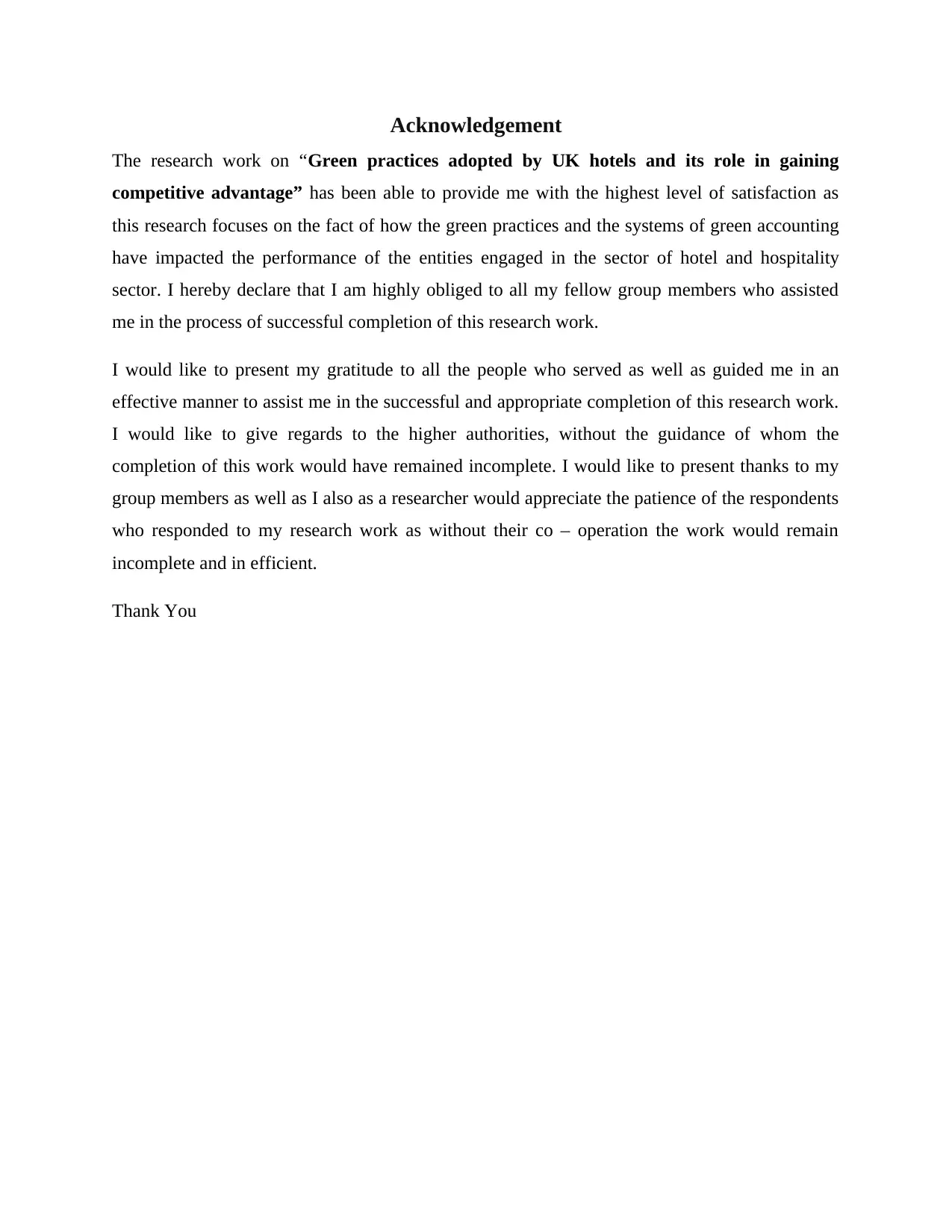
Acknowledgement
The research work on “Green practices adopted by UK hotels and its role in gaining
competitive advantage” has been able to provide me with the highest level of satisfaction as
this research focuses on the fact of how the green practices and the systems of green accounting
have impacted the performance of the entities engaged in the sector of hotel and hospitality
sector. I hereby declare that I am highly obliged to all my fellow group members who assisted
me in the process of successful completion of this research work.
I would like to present my gratitude to all the people who served as well as guided me in an
effective manner to assist me in the successful and appropriate completion of this research work.
I would like to give regards to the higher authorities, without the guidance of whom the
completion of this work would have remained incomplete. I would like to present thanks to my
group members as well as I also as a researcher would appreciate the patience of the respondents
who responded to my research work as without their co – operation the work would remain
incomplete and in efficient.
Thank You
The research work on “Green practices adopted by UK hotels and its role in gaining
competitive advantage” has been able to provide me with the highest level of satisfaction as
this research focuses on the fact of how the green practices and the systems of green accounting
have impacted the performance of the entities engaged in the sector of hotel and hospitality
sector. I hereby declare that I am highly obliged to all my fellow group members who assisted
me in the process of successful completion of this research work.
I would like to present my gratitude to all the people who served as well as guided me in an
effective manner to assist me in the successful and appropriate completion of this research work.
I would like to give regards to the higher authorities, without the guidance of whom the
completion of this work would have remained incomplete. I would like to present thanks to my
group members as well as I also as a researcher would appreciate the patience of the respondents
who responded to my research work as without their co – operation the work would remain
incomplete and in efficient.
Thank You
⊘ This is a preview!⊘
Do you want full access?
Subscribe today to unlock all pages.

Trusted by 1+ million students worldwide
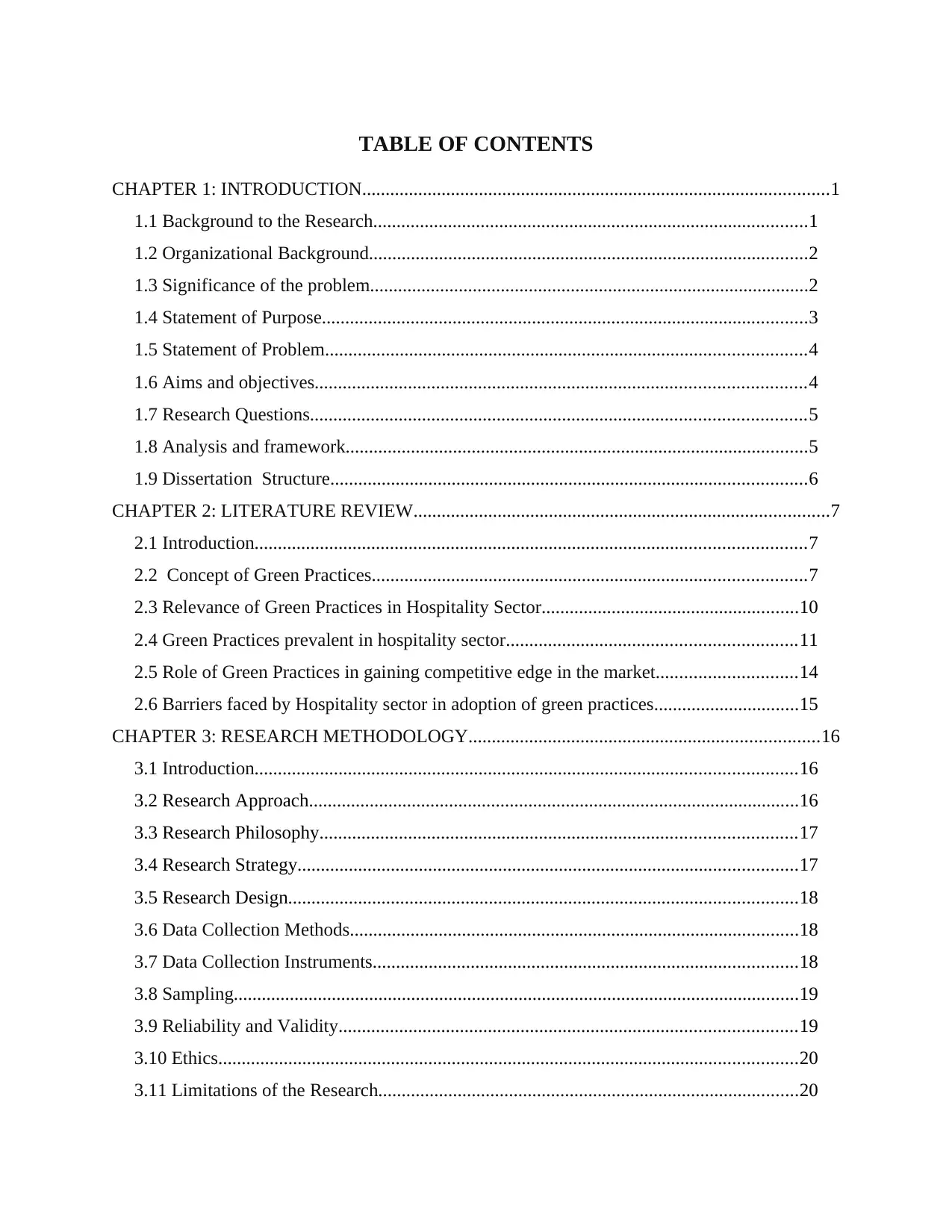
TABLE OF CONTENTS
CHAPTER 1: INTRODUCTION....................................................................................................1
1.1 Background to the Research.............................................................................................1
1.2 Organizational Background..............................................................................................2
1.3 Significance of the problem..............................................................................................2
1.4 Statement of Purpose........................................................................................................3
1.5 Statement of Problem.......................................................................................................4
1.6 Aims and objectives.........................................................................................................4
1.7 Research Questions..........................................................................................................5
1.8 Analysis and framework...................................................................................................5
1.9 Dissertation Structure......................................................................................................6
CHAPTER 2: LITERATURE REVIEW.........................................................................................7
2.1 Introduction......................................................................................................................7
2.2 Concept of Green Practices.............................................................................................7
2.3 Relevance of Green Practices in Hospitality Sector.......................................................10
2.4 Green Practices prevalent in hospitality sector..............................................................11
2.5 Role of Green Practices in gaining competitive edge in the market..............................14
2.6 Barriers faced by Hospitality sector in adoption of green practices...............................15
CHAPTER 3: RESEARCH METHODOLOGY...........................................................................16
3.1 Introduction....................................................................................................................16
3.2 Research Approach.........................................................................................................16
3.3 Research Philosophy......................................................................................................17
3.4 Research Strategy...........................................................................................................17
3.5 Research Design.............................................................................................................18
3.6 Data Collection Methods................................................................................................18
3.7 Data Collection Instruments...........................................................................................18
3.8 Sampling.........................................................................................................................19
3.9 Reliability and Validity..................................................................................................19
3.10 Ethics............................................................................................................................20
3.11 Limitations of the Research..........................................................................................20
CHAPTER 1: INTRODUCTION....................................................................................................1
1.1 Background to the Research.............................................................................................1
1.2 Organizational Background..............................................................................................2
1.3 Significance of the problem..............................................................................................2
1.4 Statement of Purpose........................................................................................................3
1.5 Statement of Problem.......................................................................................................4
1.6 Aims and objectives.........................................................................................................4
1.7 Research Questions..........................................................................................................5
1.8 Analysis and framework...................................................................................................5
1.9 Dissertation Structure......................................................................................................6
CHAPTER 2: LITERATURE REVIEW.........................................................................................7
2.1 Introduction......................................................................................................................7
2.2 Concept of Green Practices.............................................................................................7
2.3 Relevance of Green Practices in Hospitality Sector.......................................................10
2.4 Green Practices prevalent in hospitality sector..............................................................11
2.5 Role of Green Practices in gaining competitive edge in the market..............................14
2.6 Barriers faced by Hospitality sector in adoption of green practices...............................15
CHAPTER 3: RESEARCH METHODOLOGY...........................................................................16
3.1 Introduction....................................................................................................................16
3.2 Research Approach.........................................................................................................16
3.3 Research Philosophy......................................................................................................17
3.4 Research Strategy...........................................................................................................17
3.5 Research Design.............................................................................................................18
3.6 Data Collection Methods................................................................................................18
3.7 Data Collection Instruments...........................................................................................18
3.8 Sampling.........................................................................................................................19
3.9 Reliability and Validity..................................................................................................19
3.10 Ethics............................................................................................................................20
3.11 Limitations of the Research..........................................................................................20
Paraphrase This Document
Need a fresh take? Get an instant paraphrase of this document with our AI Paraphraser
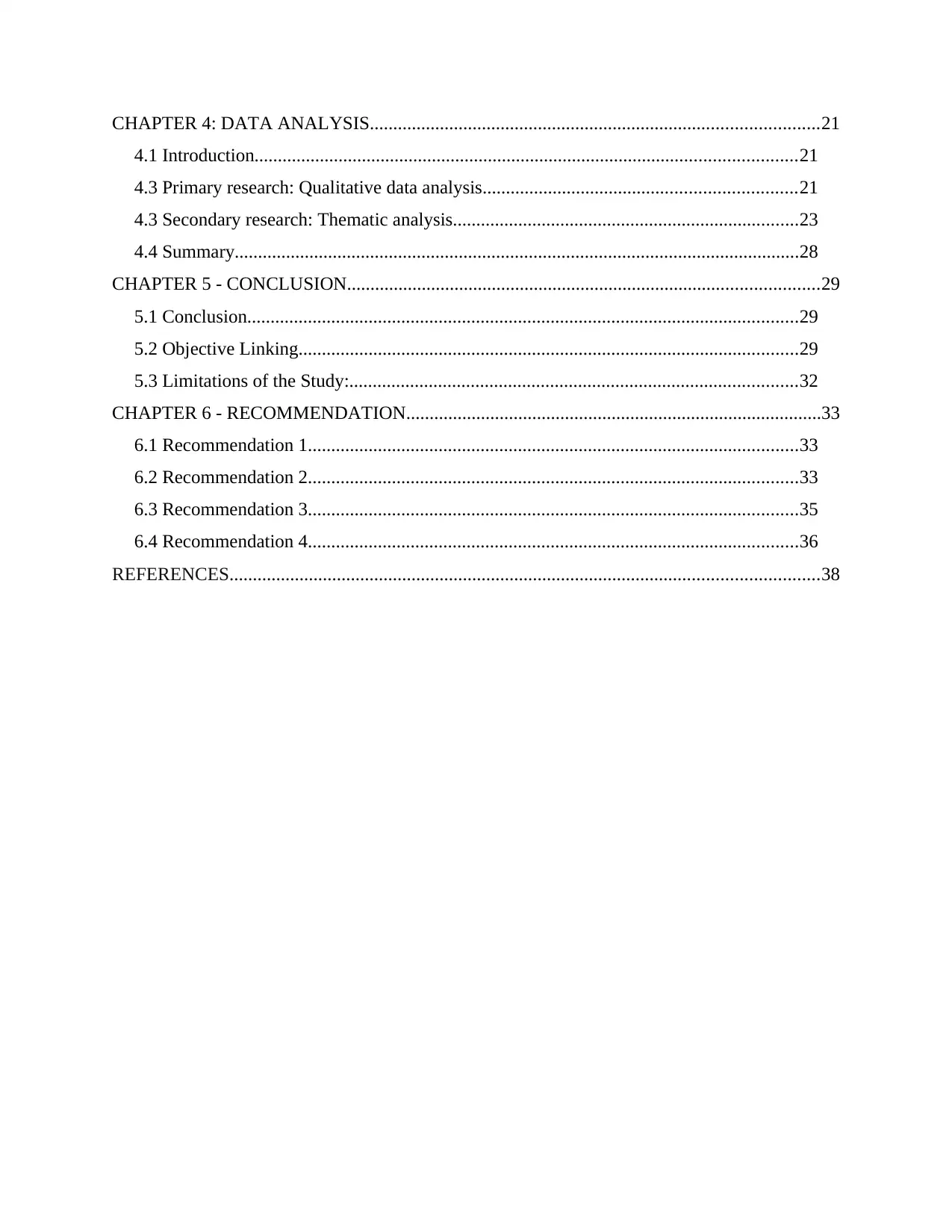
CHAPTER 4: DATA ANALYSIS................................................................................................21
4.1 Introduction....................................................................................................................21
4.3 Primary research: Qualitative data analysis...................................................................21
4.3 Secondary research: Thematic analysis..........................................................................23
4.4 Summary.........................................................................................................................28
CHAPTER 5 - CONCLUSION.....................................................................................................29
5.1 Conclusion......................................................................................................................29
5.2 Objective Linking...........................................................................................................29
5.3 Limitations of the Study:................................................................................................32
CHAPTER 6 - RECOMMENDATION.........................................................................................33
6.1 Recommendation 1.........................................................................................................33
6.2 Recommendation 2.........................................................................................................33
6.3 Recommendation 3.........................................................................................................35
6.4 Recommendation 4.........................................................................................................36
REFERENCES..............................................................................................................................38
4.1 Introduction....................................................................................................................21
4.3 Primary research: Qualitative data analysis...................................................................21
4.3 Secondary research: Thematic analysis..........................................................................23
4.4 Summary.........................................................................................................................28
CHAPTER 5 - CONCLUSION.....................................................................................................29
5.1 Conclusion......................................................................................................................29
5.2 Objective Linking...........................................................................................................29
5.3 Limitations of the Study:................................................................................................32
CHAPTER 6 - RECOMMENDATION.........................................................................................33
6.1 Recommendation 1.........................................................................................................33
6.2 Recommendation 2.........................................................................................................33
6.3 Recommendation 3.........................................................................................................35
6.4 Recommendation 4.........................................................................................................36
REFERENCES..............................................................................................................................38
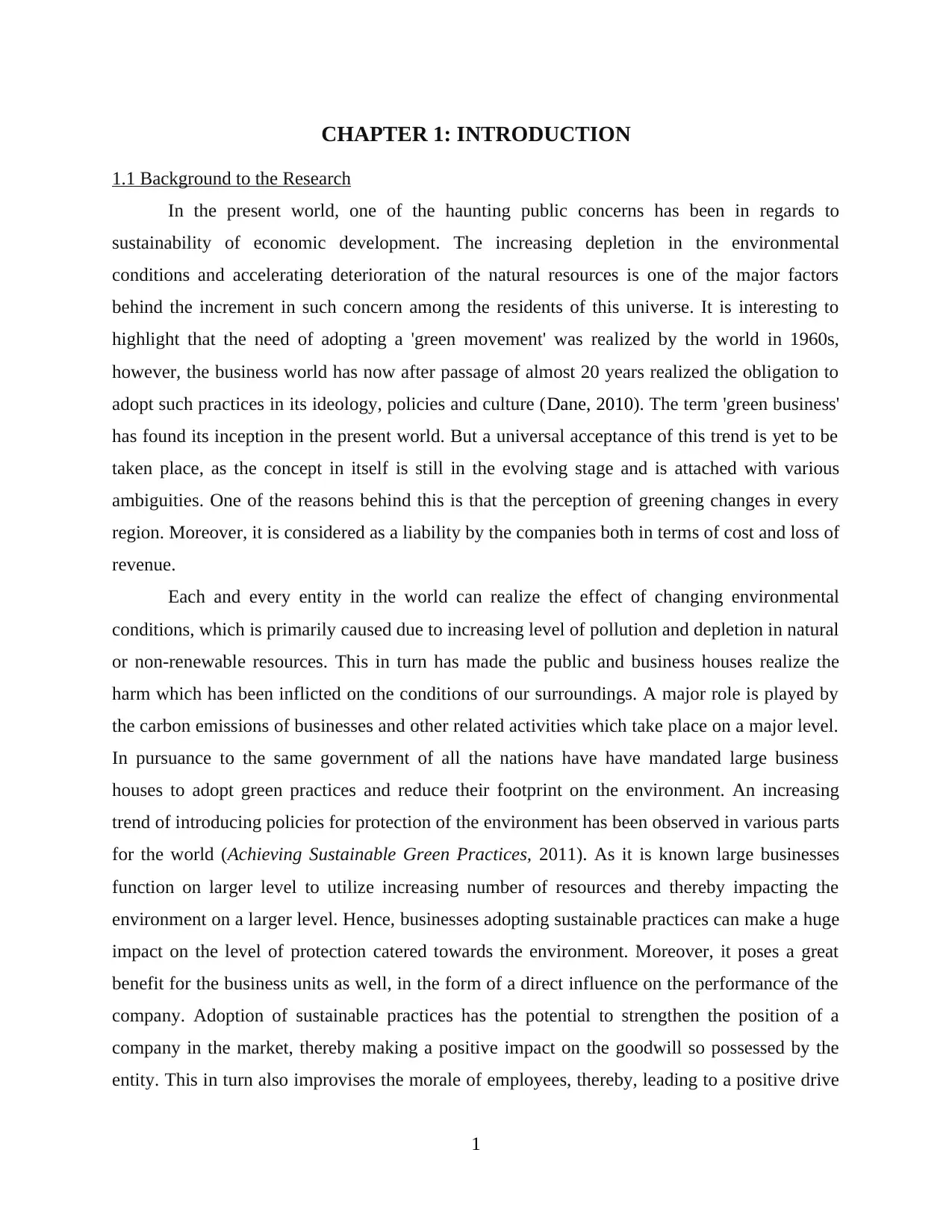
CHAPTER 1: INTRODUCTION
1.1 Background to the Research
In the present world, one of the haunting public concerns has been in regards to
sustainability of economic development. The increasing depletion in the environmental
conditions and accelerating deterioration of the natural resources is one of the major factors
behind the increment in such concern among the residents of this universe. It is interesting to
highlight that the need of adopting a 'green movement' was realized by the world in 1960s,
however, the business world has now after passage of almost 20 years realized the obligation to
adopt such practices in its ideology, policies and culture (Dane, 2010). The term 'green business'
has found its inception in the present world. But a universal acceptance of this trend is yet to be
taken place, as the concept in itself is still in the evolving stage and is attached with various
ambiguities. One of the reasons behind this is that the perception of greening changes in every
region. Moreover, it is considered as a liability by the companies both in terms of cost and loss of
revenue.
Each and every entity in the world can realize the effect of changing environmental
conditions, which is primarily caused due to increasing level of pollution and depletion in natural
or non-renewable resources. This in turn has made the public and business houses realize the
harm which has been inflicted on the conditions of our surroundings. A major role is played by
the carbon emissions of businesses and other related activities which take place on a major level.
In pursuance to the same government of all the nations have have mandated large business
houses to adopt green practices and reduce their footprint on the environment. An increasing
trend of introducing policies for protection of the environment has been observed in various parts
for the world (Achieving Sustainable Green Practices, 2011). As it is known large businesses
function on larger level to utilize increasing number of resources and thereby impacting the
environment on a larger level. Hence, businesses adopting sustainable practices can make a huge
impact on the level of protection catered towards the environment. Moreover, it poses a great
benefit for the business units as well, in the form of a direct influence on the performance of the
company. Adoption of sustainable practices has the potential to strengthen the position of a
company in the market, thereby making a positive impact on the goodwill so possessed by the
entity. This in turn also improvises the morale of employees, thereby, leading to a positive drive
1
1.1 Background to the Research
In the present world, one of the haunting public concerns has been in regards to
sustainability of economic development. The increasing depletion in the environmental
conditions and accelerating deterioration of the natural resources is one of the major factors
behind the increment in such concern among the residents of this universe. It is interesting to
highlight that the need of adopting a 'green movement' was realized by the world in 1960s,
however, the business world has now after passage of almost 20 years realized the obligation to
adopt such practices in its ideology, policies and culture (Dane, 2010). The term 'green business'
has found its inception in the present world. But a universal acceptance of this trend is yet to be
taken place, as the concept in itself is still in the evolving stage and is attached with various
ambiguities. One of the reasons behind this is that the perception of greening changes in every
region. Moreover, it is considered as a liability by the companies both in terms of cost and loss of
revenue.
Each and every entity in the world can realize the effect of changing environmental
conditions, which is primarily caused due to increasing level of pollution and depletion in natural
or non-renewable resources. This in turn has made the public and business houses realize the
harm which has been inflicted on the conditions of our surroundings. A major role is played by
the carbon emissions of businesses and other related activities which take place on a major level.
In pursuance to the same government of all the nations have have mandated large business
houses to adopt green practices and reduce their footprint on the environment. An increasing
trend of introducing policies for protection of the environment has been observed in various parts
for the world (Achieving Sustainable Green Practices, 2011). As it is known large businesses
function on larger level to utilize increasing number of resources and thereby impacting the
environment on a larger level. Hence, businesses adopting sustainable practices can make a huge
impact on the level of protection catered towards the environment. Moreover, it poses a great
benefit for the business units as well, in the form of a direct influence on the performance of the
company. Adoption of sustainable practices has the potential to strengthen the position of a
company in the market, thereby making a positive impact on the goodwill so possessed by the
entity. This in turn also improvises the morale of employees, thereby, leading to a positive drive
1
⊘ This is a preview!⊘
Do you want full access?
Subscribe today to unlock all pages.

Trusted by 1+ million students worldwide
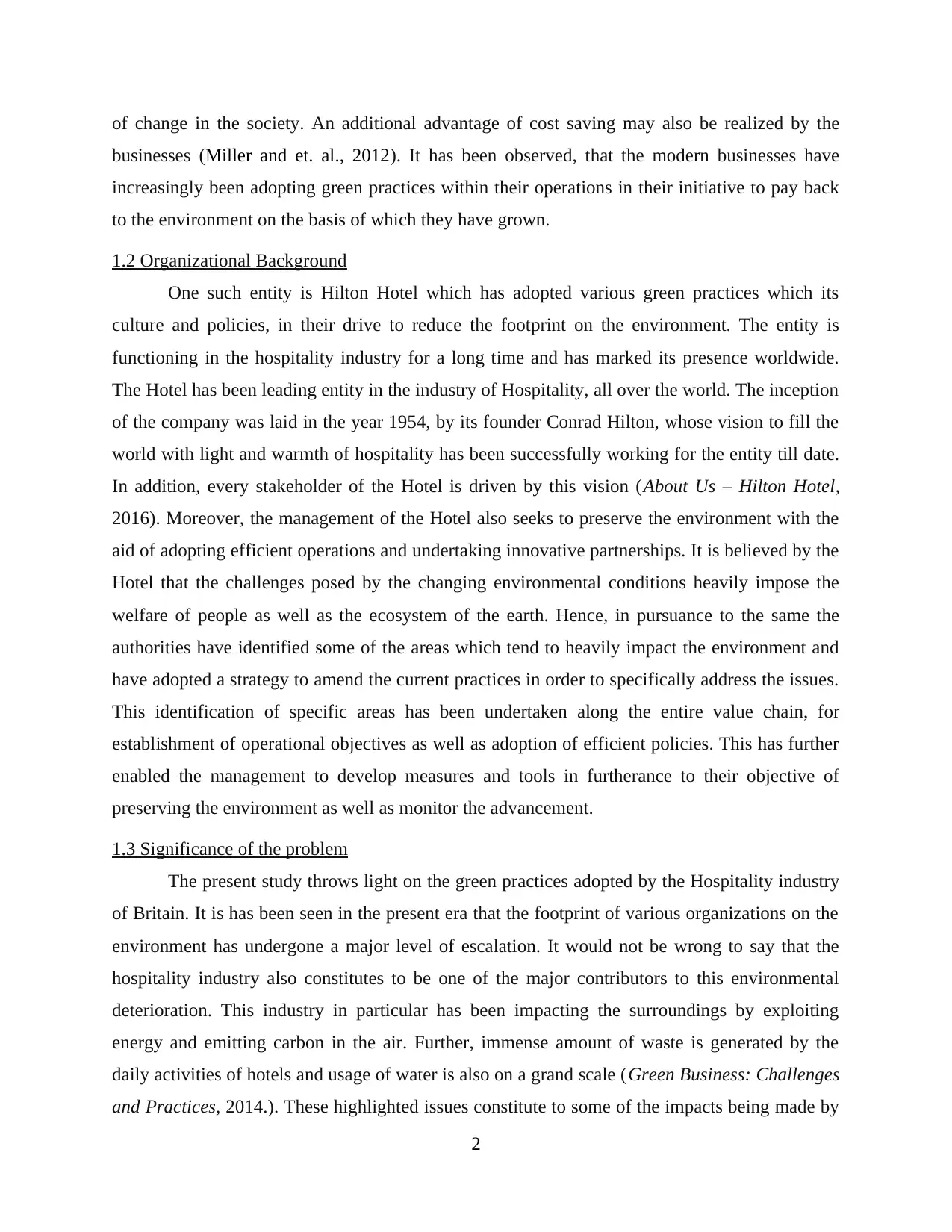
of change in the society. An additional advantage of cost saving may also be realized by the
businesses (Miller and et. al., 2012). It has been observed, that the modern businesses have
increasingly been adopting green practices within their operations in their initiative to pay back
to the environment on the basis of which they have grown.
1.2 Organizational Background
One such entity is Hilton Hotel which has adopted various green practices which its
culture and policies, in their drive to reduce the footprint on the environment. The entity is
functioning in the hospitality industry for a long time and has marked its presence worldwide.
The Hotel has been leading entity in the industry of Hospitality, all over the world. The inception
of the company was laid in the year 1954, by its founder Conrad Hilton, whose vision to fill the
world with light and warmth of hospitality has been successfully working for the entity till date.
In addition, every stakeholder of the Hotel is driven by this vision (About Us – Hilton Hotel,
2016). Moreover, the management of the Hotel also seeks to preserve the environment with the
aid of adopting efficient operations and undertaking innovative partnerships. It is believed by the
Hotel that the challenges posed by the changing environmental conditions heavily impose the
welfare of people as well as the ecosystem of the earth. Hence, in pursuance to the same the
authorities have identified some of the areas which tend to heavily impact the environment and
have adopted a strategy to amend the current practices in order to specifically address the issues.
This identification of specific areas has been undertaken along the entire value chain, for
establishment of operational objectives as well as adoption of efficient policies. This has further
enabled the management to develop measures and tools in furtherance to their objective of
preserving the environment as well as monitor the advancement.
1.3 Significance of the problem
The present study throws light on the green practices adopted by the Hospitality industry
of Britain. It is has been seen in the present era that the footprint of various organizations on the
environment has undergone a major level of escalation. It would not be wrong to say that the
hospitality industry also constitutes to be one of the major contributors to this environmental
deterioration. This industry in particular has been impacting the surroundings by exploiting
energy and emitting carbon in the air. Further, immense amount of waste is generated by the
daily activities of hotels and usage of water is also on a grand scale (Green Business: Challenges
and Practices, 2014.). These highlighted issues constitute to some of the impacts being made by
2
businesses (Miller and et. al., 2012). It has been observed, that the modern businesses have
increasingly been adopting green practices within their operations in their initiative to pay back
to the environment on the basis of which they have grown.
1.2 Organizational Background
One such entity is Hilton Hotel which has adopted various green practices which its
culture and policies, in their drive to reduce the footprint on the environment. The entity is
functioning in the hospitality industry for a long time and has marked its presence worldwide.
The Hotel has been leading entity in the industry of Hospitality, all over the world. The inception
of the company was laid in the year 1954, by its founder Conrad Hilton, whose vision to fill the
world with light and warmth of hospitality has been successfully working for the entity till date.
In addition, every stakeholder of the Hotel is driven by this vision (About Us – Hilton Hotel,
2016). Moreover, the management of the Hotel also seeks to preserve the environment with the
aid of adopting efficient operations and undertaking innovative partnerships. It is believed by the
Hotel that the challenges posed by the changing environmental conditions heavily impose the
welfare of people as well as the ecosystem of the earth. Hence, in pursuance to the same the
authorities have identified some of the areas which tend to heavily impact the environment and
have adopted a strategy to amend the current practices in order to specifically address the issues.
This identification of specific areas has been undertaken along the entire value chain, for
establishment of operational objectives as well as adoption of efficient policies. This has further
enabled the management to develop measures and tools in furtherance to their objective of
preserving the environment as well as monitor the advancement.
1.3 Significance of the problem
The present study throws light on the green practices adopted by the Hospitality industry
of Britain. It is has been seen in the present era that the footprint of various organizations on the
environment has undergone a major level of escalation. It would not be wrong to say that the
hospitality industry also constitutes to be one of the major contributors to this environmental
deterioration. This industry in particular has been impacting the surroundings by exploiting
energy and emitting carbon in the air. Further, immense amount of waste is generated by the
daily activities of hotels and usage of water is also on a grand scale (Green Business: Challenges
and Practices, 2014.). These highlighted issues constitute to some of the impacts being made by
2
Paraphrase This Document
Need a fresh take? Get an instant paraphrase of this document with our AI Paraphraser
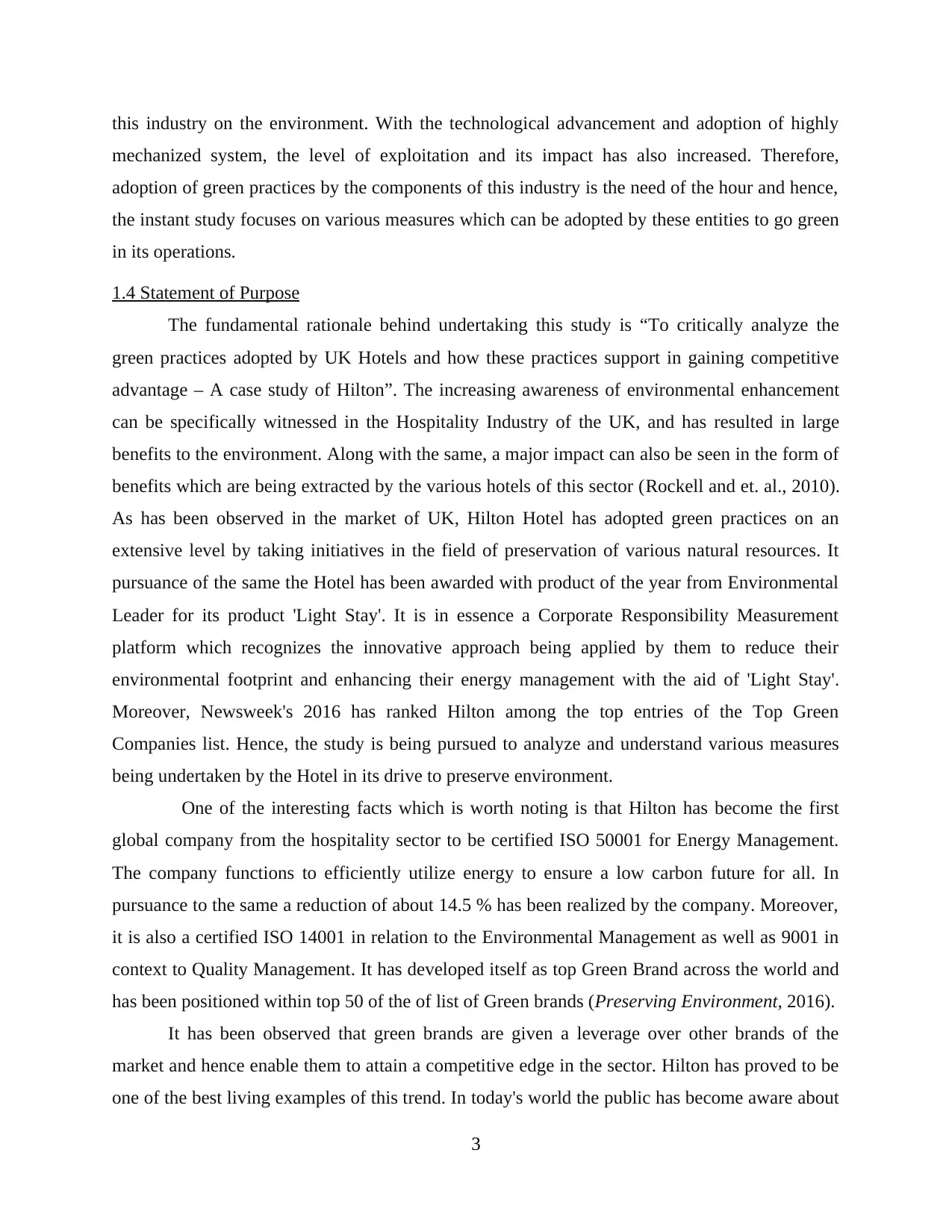
this industry on the environment. With the technological advancement and adoption of highly
mechanized system, the level of exploitation and its impact has also increased. Therefore,
adoption of green practices by the components of this industry is the need of the hour and hence,
the instant study focuses on various measures which can be adopted by these entities to go green
in its operations.
1.4 Statement of Purpose
The fundamental rationale behind undertaking this study is “To critically analyze the
green practices adopted by UK Hotels and how these practices support in gaining competitive
advantage – A case study of Hilton”. The increasing awareness of environmental enhancement
can be specifically witnessed in the Hospitality Industry of the UK, and has resulted in large
benefits to the environment. Along with the same, a major impact can also be seen in the form of
benefits which are being extracted by the various hotels of this sector (Rockell and et. al., 2010).
As has been observed in the market of UK, Hilton Hotel has adopted green practices on an
extensive level by taking initiatives in the field of preservation of various natural resources. It
pursuance of the same the Hotel has been awarded with product of the year from Environmental
Leader for its product 'Light Stay'. It is in essence a Corporate Responsibility Measurement
platform which recognizes the innovative approach being applied by them to reduce their
environmental footprint and enhancing their energy management with the aid of 'Light Stay'.
Moreover, Newsweek's 2016 has ranked Hilton among the top entries of the Top Green
Companies list. Hence, the study is being pursued to analyze and understand various measures
being undertaken by the Hotel in its drive to preserve environment.
One of the interesting facts which is worth noting is that Hilton has become the first
global company from the hospitality sector to be certified ISO 50001 for Energy Management.
The company functions to efficiently utilize energy to ensure a low carbon future for all. In
pursuance to the same a reduction of about 14.5 % has been realized by the company. Moreover,
it is also a certified ISO 14001 in relation to the Environmental Management as well as 9001 in
context to Quality Management. It has developed itself as top Green Brand across the world and
has been positioned within top 50 of the of list of Green brands (Preserving Environment, 2016).
It has been observed that green brands are given a leverage over other brands of the
market and hence enable them to attain a competitive edge in the sector. Hilton has proved to be
one of the best living examples of this trend. In today's world the public has become aware about
3
mechanized system, the level of exploitation and its impact has also increased. Therefore,
adoption of green practices by the components of this industry is the need of the hour and hence,
the instant study focuses on various measures which can be adopted by these entities to go green
in its operations.
1.4 Statement of Purpose
The fundamental rationale behind undertaking this study is “To critically analyze the
green practices adopted by UK Hotels and how these practices support in gaining competitive
advantage – A case study of Hilton”. The increasing awareness of environmental enhancement
can be specifically witnessed in the Hospitality Industry of the UK, and has resulted in large
benefits to the environment. Along with the same, a major impact can also be seen in the form of
benefits which are being extracted by the various hotels of this sector (Rockell and et. al., 2010).
As has been observed in the market of UK, Hilton Hotel has adopted green practices on an
extensive level by taking initiatives in the field of preservation of various natural resources. It
pursuance of the same the Hotel has been awarded with product of the year from Environmental
Leader for its product 'Light Stay'. It is in essence a Corporate Responsibility Measurement
platform which recognizes the innovative approach being applied by them to reduce their
environmental footprint and enhancing their energy management with the aid of 'Light Stay'.
Moreover, Newsweek's 2016 has ranked Hilton among the top entries of the Top Green
Companies list. Hence, the study is being pursued to analyze and understand various measures
being undertaken by the Hotel in its drive to preserve environment.
One of the interesting facts which is worth noting is that Hilton has become the first
global company from the hospitality sector to be certified ISO 50001 for Energy Management.
The company functions to efficiently utilize energy to ensure a low carbon future for all. In
pursuance to the same a reduction of about 14.5 % has been realized by the company. Moreover,
it is also a certified ISO 14001 in relation to the Environmental Management as well as 9001 in
context to Quality Management. It has developed itself as top Green Brand across the world and
has been positioned within top 50 of the of list of Green brands (Preserving Environment, 2016).
It has been observed that green brands are given a leverage over other brands of the
market and hence enable them to attain a competitive edge in the sector. Hilton has proved to be
one of the best living examples of this trend. In today's world the public has become aware about
3
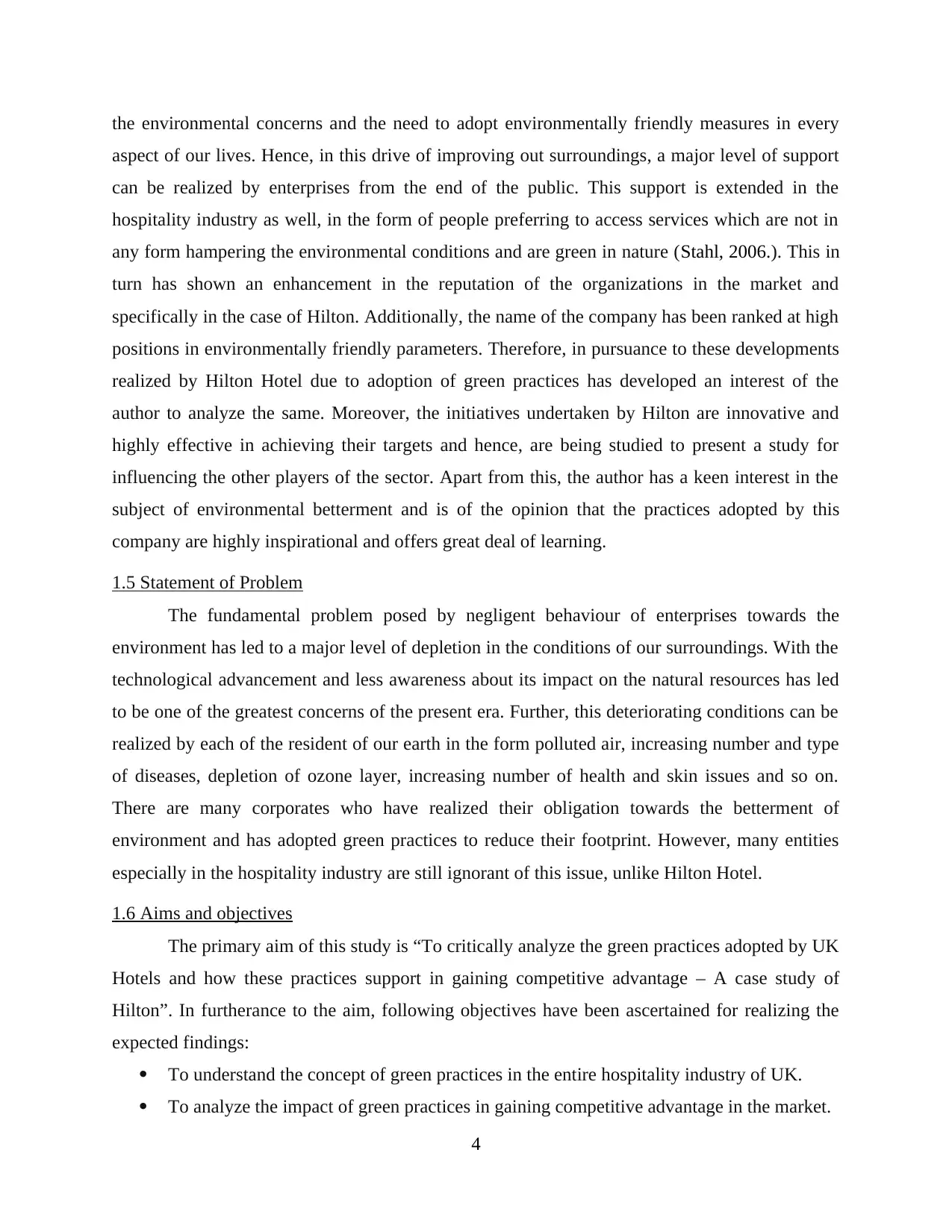
the environmental concerns and the need to adopt environmentally friendly measures in every
aspect of our lives. Hence, in this drive of improving out surroundings, a major level of support
can be realized by enterprises from the end of the public. This support is extended in the
hospitality industry as well, in the form of people preferring to access services which are not in
any form hampering the environmental conditions and are green in nature (Stahl, 2006.). This in
turn has shown an enhancement in the reputation of the organizations in the market and
specifically in the case of Hilton. Additionally, the name of the company has been ranked at high
positions in environmentally friendly parameters. Therefore, in pursuance to these developments
realized by Hilton Hotel due to adoption of green practices has developed an interest of the
author to analyze the same. Moreover, the initiatives undertaken by Hilton are innovative and
highly effective in achieving their targets and hence, are being studied to present a study for
influencing the other players of the sector. Apart from this, the author has a keen interest in the
subject of environmental betterment and is of the opinion that the practices adopted by this
company are highly inspirational and offers great deal of learning.
1.5 Statement of Problem
The fundamental problem posed by negligent behaviour of enterprises towards the
environment has led to a major level of depletion in the conditions of our surroundings. With the
technological advancement and less awareness about its impact on the natural resources has led
to be one of the greatest concerns of the present era. Further, this deteriorating conditions can be
realized by each of the resident of our earth in the form polluted air, increasing number and type
of diseases, depletion of ozone layer, increasing number of health and skin issues and so on.
There are many corporates who have realized their obligation towards the betterment of
environment and has adopted green practices to reduce their footprint. However, many entities
especially in the hospitality industry are still ignorant of this issue, unlike Hilton Hotel.
1.6 Aims and objectives
The primary aim of this study is “To critically analyze the green practices adopted by UK
Hotels and how these practices support in gaining competitive advantage – A case study of
Hilton”. In furtherance to the aim, following objectives have been ascertained for realizing the
expected findings:
To understand the concept of green practices in the entire hospitality industry of UK.
To analyze the impact of green practices in gaining competitive advantage in the market.
4
aspect of our lives. Hence, in this drive of improving out surroundings, a major level of support
can be realized by enterprises from the end of the public. This support is extended in the
hospitality industry as well, in the form of people preferring to access services which are not in
any form hampering the environmental conditions and are green in nature (Stahl, 2006.). This in
turn has shown an enhancement in the reputation of the organizations in the market and
specifically in the case of Hilton. Additionally, the name of the company has been ranked at high
positions in environmentally friendly parameters. Therefore, in pursuance to these developments
realized by Hilton Hotel due to adoption of green practices has developed an interest of the
author to analyze the same. Moreover, the initiatives undertaken by Hilton are innovative and
highly effective in achieving their targets and hence, are being studied to present a study for
influencing the other players of the sector. Apart from this, the author has a keen interest in the
subject of environmental betterment and is of the opinion that the practices adopted by this
company are highly inspirational and offers great deal of learning.
1.5 Statement of Problem
The fundamental problem posed by negligent behaviour of enterprises towards the
environment has led to a major level of depletion in the conditions of our surroundings. With the
technological advancement and less awareness about its impact on the natural resources has led
to be one of the greatest concerns of the present era. Further, this deteriorating conditions can be
realized by each of the resident of our earth in the form polluted air, increasing number and type
of diseases, depletion of ozone layer, increasing number of health and skin issues and so on.
There are many corporates who have realized their obligation towards the betterment of
environment and has adopted green practices to reduce their footprint. However, many entities
especially in the hospitality industry are still ignorant of this issue, unlike Hilton Hotel.
1.6 Aims and objectives
The primary aim of this study is “To critically analyze the green practices adopted by UK
Hotels and how these practices support in gaining competitive advantage – A case study of
Hilton”. In furtherance to the aim, following objectives have been ascertained for realizing the
expected findings:
To understand the concept of green practices in the entire hospitality industry of UK.
To analyze the impact of green practices in gaining competitive advantage in the market.
4
⊘ This is a preview!⊘
Do you want full access?
Subscribe today to unlock all pages.

Trusted by 1+ million students worldwide
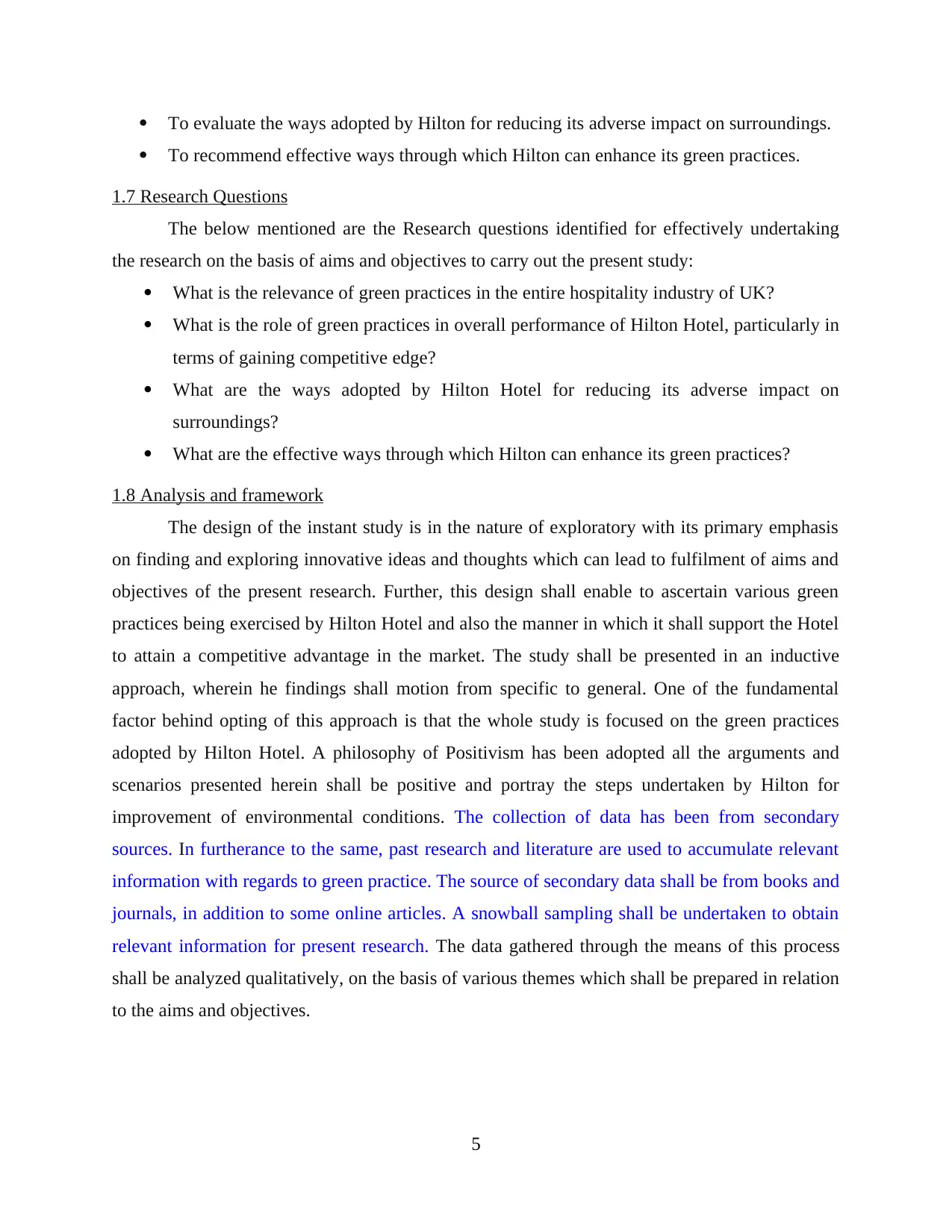
To evaluate the ways adopted by Hilton for reducing its adverse impact on surroundings.
To recommend effective ways through which Hilton can enhance its green practices.
1.7 Research Questions
The below mentioned are the Research questions identified for effectively undertaking
the research on the basis of aims and objectives to carry out the present study:
What is the relevance of green practices in the entire hospitality industry of UK?
What is the role of green practices in overall performance of Hilton Hotel, particularly in
terms of gaining competitive edge?
What are the ways adopted by Hilton Hotel for reducing its adverse impact on
surroundings?
What are the effective ways through which Hilton can enhance its green practices?
1.8 Analysis and framework
The design of the instant study is in the nature of exploratory with its primary emphasis
on finding and exploring innovative ideas and thoughts which can lead to fulfilment of aims and
objectives of the present research. Further, this design shall enable to ascertain various green
practices being exercised by Hilton Hotel and also the manner in which it shall support the Hotel
to attain a competitive advantage in the market. The study shall be presented in an inductive
approach, wherein he findings shall motion from specific to general. One of the fundamental
factor behind opting of this approach is that the whole study is focused on the green practices
adopted by Hilton Hotel. A philosophy of Positivism has been adopted all the arguments and
scenarios presented herein shall be positive and portray the steps undertaken by Hilton for
improvement of environmental conditions. The collection of data has been from secondary
sources. In furtherance to the same, past research and literature are used to accumulate relevant
information with regards to green practice. The source of secondary data shall be from books and
journals, in addition to some online articles. A snowball sampling shall be undertaken to obtain
relevant information for present research. The data gathered through the means of this process
shall be analyzed qualitatively, on the basis of various themes which shall be prepared in relation
to the aims and objectives.
5
To recommend effective ways through which Hilton can enhance its green practices.
1.7 Research Questions
The below mentioned are the Research questions identified for effectively undertaking
the research on the basis of aims and objectives to carry out the present study:
What is the relevance of green practices in the entire hospitality industry of UK?
What is the role of green practices in overall performance of Hilton Hotel, particularly in
terms of gaining competitive edge?
What are the ways adopted by Hilton Hotel for reducing its adverse impact on
surroundings?
What are the effective ways through which Hilton can enhance its green practices?
1.8 Analysis and framework
The design of the instant study is in the nature of exploratory with its primary emphasis
on finding and exploring innovative ideas and thoughts which can lead to fulfilment of aims and
objectives of the present research. Further, this design shall enable to ascertain various green
practices being exercised by Hilton Hotel and also the manner in which it shall support the Hotel
to attain a competitive advantage in the market. The study shall be presented in an inductive
approach, wherein he findings shall motion from specific to general. One of the fundamental
factor behind opting of this approach is that the whole study is focused on the green practices
adopted by Hilton Hotel. A philosophy of Positivism has been adopted all the arguments and
scenarios presented herein shall be positive and portray the steps undertaken by Hilton for
improvement of environmental conditions. The collection of data has been from secondary
sources. In furtherance to the same, past research and literature are used to accumulate relevant
information with regards to green practice. The source of secondary data shall be from books and
journals, in addition to some online articles. A snowball sampling shall be undertaken to obtain
relevant information for present research. The data gathered through the means of this process
shall be analyzed qualitatively, on the basis of various themes which shall be prepared in relation
to the aims and objectives.
5
Paraphrase This Document
Need a fresh take? Get an instant paraphrase of this document with our AI Paraphraser
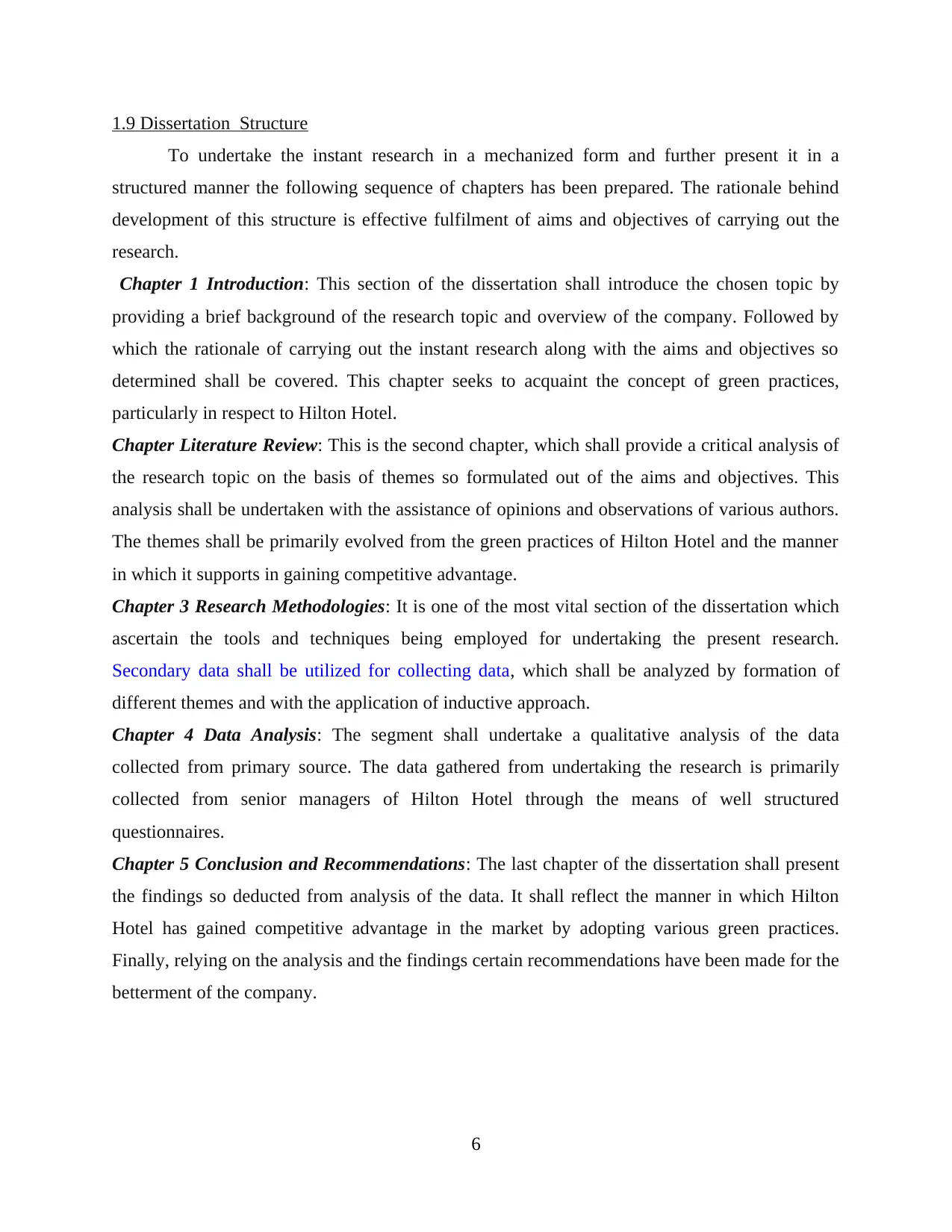
1.9 Dissertation Structure
To undertake the instant research in a mechanized form and further present it in a
structured manner the following sequence of chapters has been prepared. The rationale behind
development of this structure is effective fulfilment of aims and objectives of carrying out the
research.
Chapter 1 Introduction: This section of the dissertation shall introduce the chosen topic by
providing a brief background of the research topic and overview of the company. Followed by
which the rationale of carrying out the instant research along with the aims and objectives so
determined shall be covered. This chapter seeks to acquaint the concept of green practices,
particularly in respect to Hilton Hotel.
Chapter Literature Review: This is the second chapter, which shall provide a critical analysis of
the research topic on the basis of themes so formulated out of the aims and objectives. This
analysis shall be undertaken with the assistance of opinions and observations of various authors.
The themes shall be primarily evolved from the green practices of Hilton Hotel and the manner
in which it supports in gaining competitive advantage.
Chapter 3 Research Methodologies: It is one of the most vital section of the dissertation which
ascertain the tools and techniques being employed for undertaking the present research.
Secondary data shall be utilized for collecting data, which shall be analyzed by formation of
different themes and with the application of inductive approach.
Chapter 4 Data Analysis: The segment shall undertake a qualitative analysis of the data
collected from primary source. The data gathered from undertaking the research is primarily
collected from senior managers of Hilton Hotel through the means of well structured
questionnaires.
Chapter 5 Conclusion and Recommendations: The last chapter of the dissertation shall present
the findings so deducted from analysis of the data. It shall reflect the manner in which Hilton
Hotel has gained competitive advantage in the market by adopting various green practices.
Finally, relying on the analysis and the findings certain recommendations have been made for the
betterment of the company.
6
To undertake the instant research in a mechanized form and further present it in a
structured manner the following sequence of chapters has been prepared. The rationale behind
development of this structure is effective fulfilment of aims and objectives of carrying out the
research.
Chapter 1 Introduction: This section of the dissertation shall introduce the chosen topic by
providing a brief background of the research topic and overview of the company. Followed by
which the rationale of carrying out the instant research along with the aims and objectives so
determined shall be covered. This chapter seeks to acquaint the concept of green practices,
particularly in respect to Hilton Hotel.
Chapter Literature Review: This is the second chapter, which shall provide a critical analysis of
the research topic on the basis of themes so formulated out of the aims and objectives. This
analysis shall be undertaken with the assistance of opinions and observations of various authors.
The themes shall be primarily evolved from the green practices of Hilton Hotel and the manner
in which it supports in gaining competitive advantage.
Chapter 3 Research Methodologies: It is one of the most vital section of the dissertation which
ascertain the tools and techniques being employed for undertaking the present research.
Secondary data shall be utilized for collecting data, which shall be analyzed by formation of
different themes and with the application of inductive approach.
Chapter 4 Data Analysis: The segment shall undertake a qualitative analysis of the data
collected from primary source. The data gathered from undertaking the research is primarily
collected from senior managers of Hilton Hotel through the means of well structured
questionnaires.
Chapter 5 Conclusion and Recommendations: The last chapter of the dissertation shall present
the findings so deducted from analysis of the data. It shall reflect the manner in which Hilton
Hotel has gained competitive advantage in the market by adopting various green practices.
Finally, relying on the analysis and the findings certain recommendations have been made for the
betterment of the company.
6
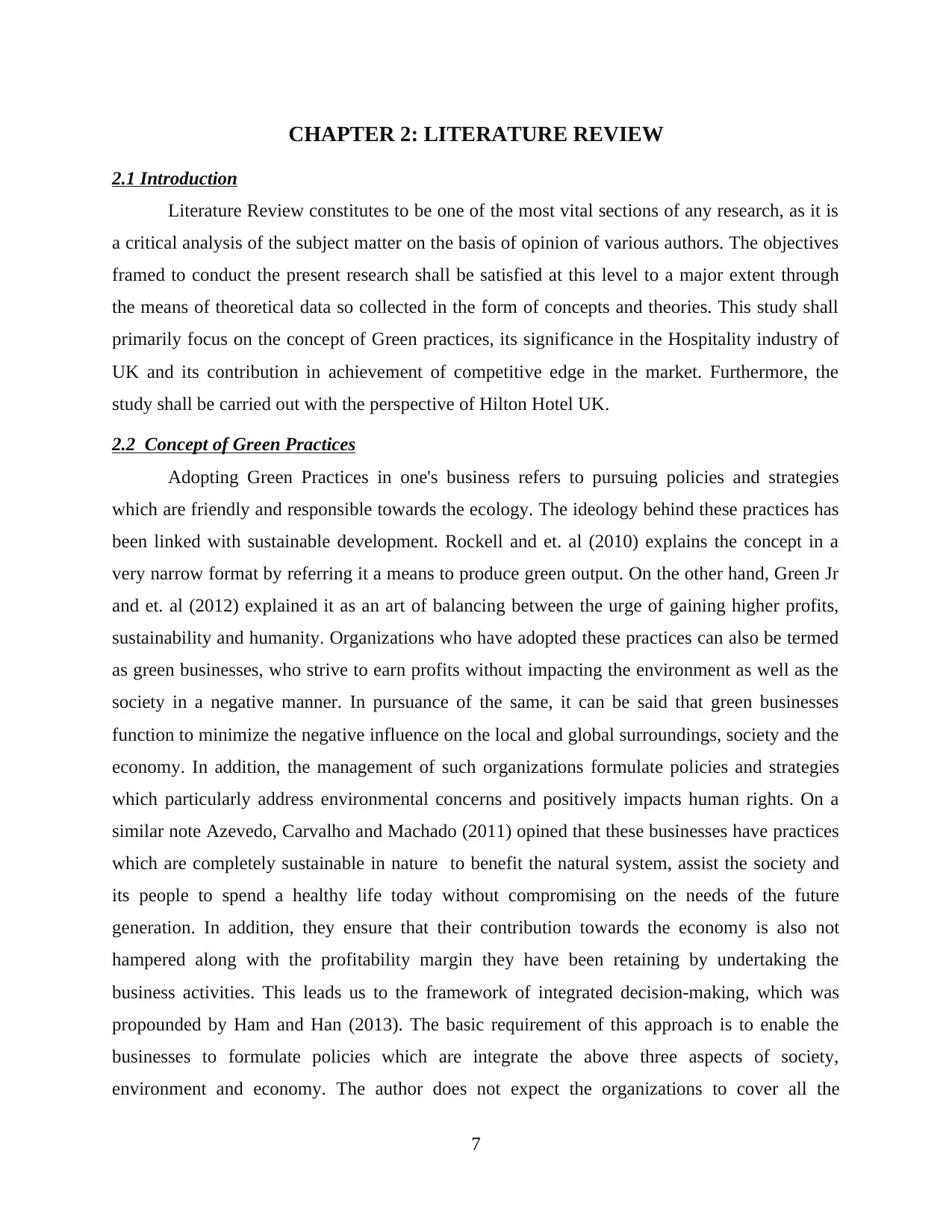
CHAPTER 2: LITERATURE REVIEW
2.1 Introduction
Literature Review constitutes to be one of the most vital sections of any research, as it is
a critical analysis of the subject matter on the basis of opinion of various authors. The objectives
framed to conduct the present research shall be satisfied at this level to a major extent through
the means of theoretical data so collected in the form of concepts and theories. This study shall
primarily focus on the concept of Green practices, its significance in the Hospitality industry of
UK and its contribution in achievement of competitive edge in the market. Furthermore, the
study shall be carried out with the perspective of Hilton Hotel UK.
2.2 Concept of Green Practices
Adopting Green Practices in one's business refers to pursuing policies and strategies
which are friendly and responsible towards the ecology. The ideology behind these practices has
been linked with sustainable development. Rockell and et. al (2010) explains the concept in a
very narrow format by referring it a means to produce green output. On the other hand, Green Jr
and et. al (2012) explained it as an art of balancing between the urge of gaining higher profits,
sustainability and humanity. Organizations who have adopted these practices can also be termed
as green businesses, who strive to earn profits without impacting the environment as well as the
society in a negative manner. In pursuance of the same, it can be said that green businesses
function to minimize the negative influence on the local and global surroundings, society and the
economy. In addition, the management of such organizations formulate policies and strategies
which particularly address environmental concerns and positively impacts human rights. On a
similar note Azevedo, Carvalho and Machado (2011) opined that these businesses have practices
which are completely sustainable in nature to benefit the natural system, assist the society and
its people to spend a healthy life today without compromising on the needs of the future
generation. In addition, they ensure that their contribution towards the economy is also not
hampered along with the profitability margin they have been retaining by undertaking the
business activities. This leads us to the framework of integrated decision-making, which was
propounded by Ham and Han (2013). The basic requirement of this approach is to enable the
businesses to formulate policies which are integrate the above three aspects of society,
environment and economy. The author does not expect the organizations to cover all the
7
2.1 Introduction
Literature Review constitutes to be one of the most vital sections of any research, as it is
a critical analysis of the subject matter on the basis of opinion of various authors. The objectives
framed to conduct the present research shall be satisfied at this level to a major extent through
the means of theoretical data so collected in the form of concepts and theories. This study shall
primarily focus on the concept of Green practices, its significance in the Hospitality industry of
UK and its contribution in achievement of competitive edge in the market. Furthermore, the
study shall be carried out with the perspective of Hilton Hotel UK.
2.2 Concept of Green Practices
Adopting Green Practices in one's business refers to pursuing policies and strategies
which are friendly and responsible towards the ecology. The ideology behind these practices has
been linked with sustainable development. Rockell and et. al (2010) explains the concept in a
very narrow format by referring it a means to produce green output. On the other hand, Green Jr
and et. al (2012) explained it as an art of balancing between the urge of gaining higher profits,
sustainability and humanity. Organizations who have adopted these practices can also be termed
as green businesses, who strive to earn profits without impacting the environment as well as the
society in a negative manner. In pursuance of the same, it can be said that green businesses
function to minimize the negative influence on the local and global surroundings, society and the
economy. In addition, the management of such organizations formulate policies and strategies
which particularly address environmental concerns and positively impacts human rights. On a
similar note Azevedo, Carvalho and Machado (2011) opined that these businesses have practices
which are completely sustainable in nature to benefit the natural system, assist the society and
its people to spend a healthy life today without compromising on the needs of the future
generation. In addition, they ensure that their contribution towards the economy is also not
hampered along with the profitability margin they have been retaining by undertaking the
business activities. This leads us to the framework of integrated decision-making, which was
propounded by Ham and Han (2013). The basic requirement of this approach is to enable the
businesses to formulate policies which are integrate the above three aspects of society,
environment and economy. The author does not expect the organizations to cover all the
7
⊘ This is a preview!⊘
Do you want full access?
Subscribe today to unlock all pages.

Trusted by 1+ million students worldwide
1 out of 44
Related Documents
Your All-in-One AI-Powered Toolkit for Academic Success.
+13062052269
info@desklib.com
Available 24*7 on WhatsApp / Email
![[object Object]](/_next/static/media/star-bottom.7253800d.svg)
Unlock your academic potential
Copyright © 2020–2025 A2Z Services. All Rights Reserved. Developed and managed by ZUCOL.





